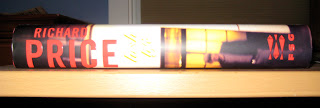 We went to see Baxter give a reading here recently, a double-billing with Richard Price (whose new novel Lush Life I’ve also just finished, and thoroughly enjoyed), in which he explained the origin of The Soul Thief. When he was young, he said, he’d had a friend in Los Angeles he used to exchange manuscripts with so they could give each other feedback. At one point, he’d had a couple stories published, and then discovered that his friend had been going around the L.A. area giving readings of his stories, presenting himself as Charles Baxter. (I may have gotten some of the details wrong here, but that was the gist of it.)
We went to see Baxter give a reading here recently, a double-billing with Richard Price (whose new novel Lush Life I’ve also just finished, and thoroughly enjoyed), in which he explained the origin of The Soul Thief. When he was young, he said, he’d had a friend in Los Angeles he used to exchange manuscripts with so they could give each other feedback. At one point, he’d had a couple stories published, and then discovered that his friend had been going around the L.A. area giving readings of his stories, presenting himself as Charles Baxter. (I may have gotten some of the details wrong here, but that was the gist of it.)
Needless to say, he had no idea what to do with this, except that he knew it was too strange not to write about. But he kept putting it off, until a few decades later, he decided to finally sit down and get it out.
The resulting novel is about the relationship between Nathaniel Mason, a poor graduate student in Buffalo, and Jerome Coolberg, the brilliantly eccentric fellow student and titular soul thief who begins appropriating parts of Nathaniel’s identity both physical and metaphysical. Eventually Nathaniel is driven to a mental breakdown, and the book skips forward thirty years, to find Nathaniel settled down in a relatively normal domestic life, until Coolberg suddenly contacts him again out of the blue, and they meet again for the first time since Nathaniel’s breakdown.
The book is shot through with doublings and mirrors—the young Nathaniel involving himself with both another odd fellow student, Theresa, and a lesbian artist, Jamie, who works at a soup kitchen with him; at one point Nathaniel and Theresa even go to a literal room of mirrors—and has Baxter’s usual sharp intelligence and careful attention to structure, character, and language. On those counts, it’s an unmitigated pleasure to read. The twist ending—which I won’t give away, but which throws a considerable amount of the rest of the book into doubt—is, from the other reviews I’ve come across, considered either the place where the book succeeds best, the place where it lets you down after an otherwise excellent read, or the place where it falls flat on its face and drags everything else down with it. (And no, don’t worry, it’s nothing so gauche as Coolberg being a figment of Nathaniel’s imagination.)
You can’t really say a whole lot about it without giving away too much, so I’ll just say that for my money, it works well enough. But I suspect it might not have if the book weren’t so short—210 pages, and small pages at that. At that level of investment, a bit of cunning trickery goes a lot further, and is a lot less likely to elicit resentment, than it might in a 400- or 500-pager.
If you’re already a Baxter fan, by all means pick this one up. If you haven’t read him before—well, you should, but I’d probably suggest starting with his well-known The Feast of Love (a National Book Award finalist, and rightly so) or with the superb story collections Through the Safety Net and Believers.
(Interesting side note: In the second half, we learn that Nathaniel has two children, Jeremy and Michael. At the reading, Baxter was asked whether Nathaniel would really give his first child a name so close to the name of his old antagonist, and what was up with that. Baxter—seeming slightly embarrassed—confessed that he hadn’t even noticed the similarity until people had started asking him about it after the book was published. It was just one of those accidental things that happens from time to time when you’re writing a novel, he said, and “I guess it is what it is.” Whether he gave his editor a hard time for not bringing it to his attention, he didn't say.)




















